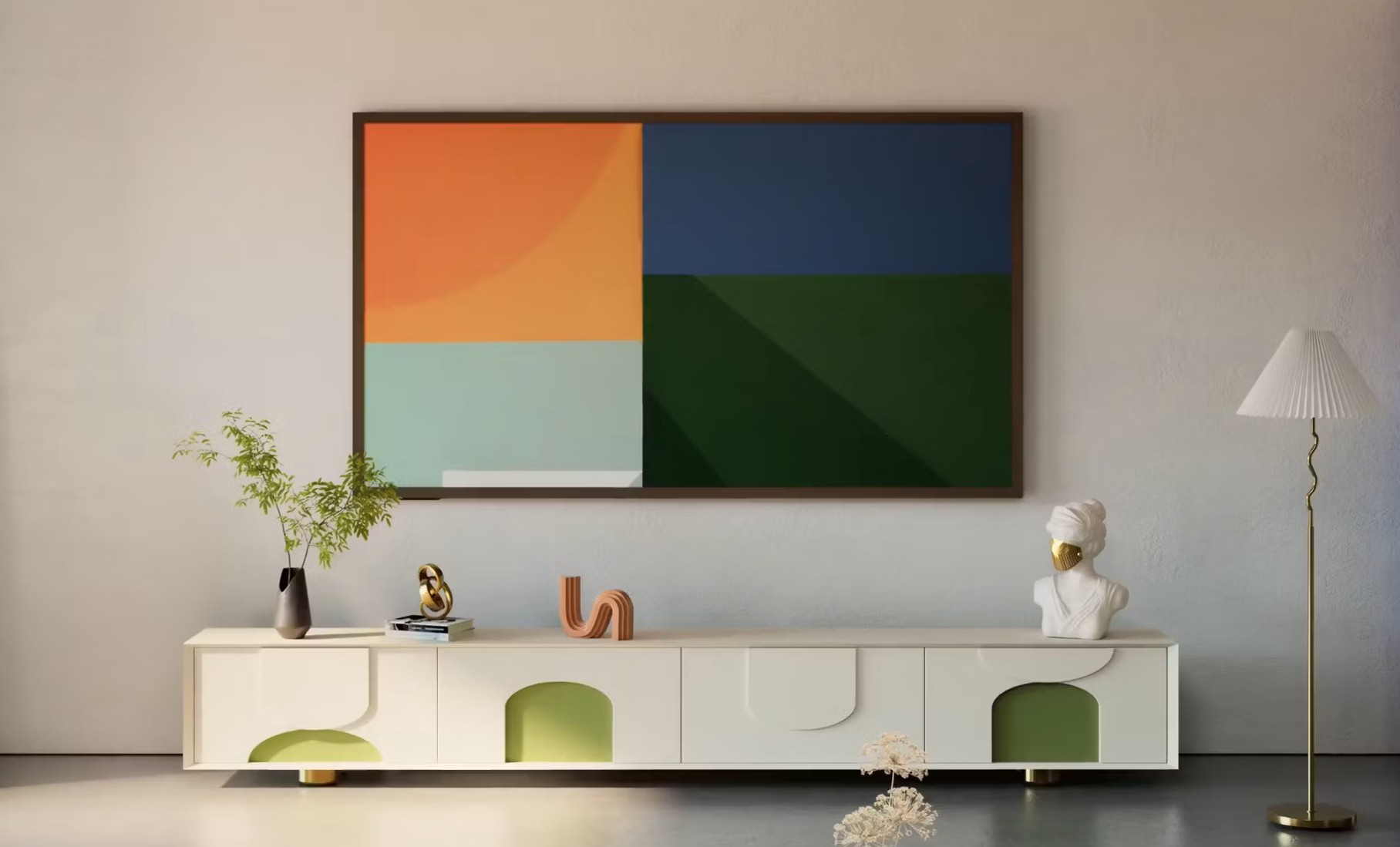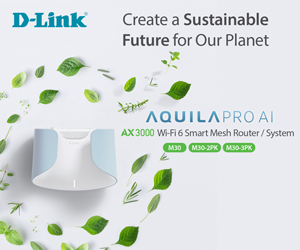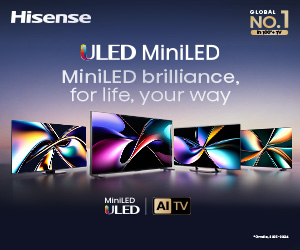The Hisense Canvas S7NAU is a 4K QLED TV with a Hi-Matte display and free art mode for over 1000 diverse art pieces. You can also use your photos to bring memories alive. Oh, and it has a faux wood picture frame as well.
To position this TV, it is a QLED – Quantum Dot, Edge-lit, LCD TV. So, it won’t have the same brightness and saturation as Mini-LED, but that is OK because it is hundreds of dollars cheaper. It’s a great TV for general use.
Now to preferences. If you have the money, you will see an image quality difference between this and the Hisense U7NAU 4K mini-LED TV – value without compromise and, more so, the Hisense U8NAU 4K mini-LED TV – premium quality at a not-so-premium price. But you lose the art mode.
To put it in perspective, it has about 450 nits peak sustained brightness, which is well below the 1000 nits recommended for Dolby Vision. It has HDR10+ Adaptive and Dolby Vision IQ processing but not DTS:X and Dolby Atmos sound, as it has 2 x 10 W speakers (you need a DA soundbar to use this).
So, our recommendation is great for Standard Definition Range (SDR) but only offers a faux Dolby Vision IQ or HDR10+. And yes, it competes directly with Samsung’s Frame, which is also QD, Edge-lit.
Read: Confused about TV tech? That’s just what they want!
Australian review: Hisense Canvas S7NAU 2024
Note: This is not the international version running Google TV – the specifications are quite different for the AU VIDAA U8 version. The letter N is for the 2024 model, and AU is for Australia. You must disregard any international reviews as these are invariably based on different panels, operating systems, and electronics used in UK, European, Chinese, and US models (Google TV).
| Website | 2024 TV range Product page User Guide |
| Price RRP | 55/65” $1799/2299 but seen as low as $1294/$1595 at Harvey Norman. |
| From | Harvey Norman, JB Hi-Fi, Good Guys, Bing Lee, Appliance Central, Retravision, Videopro |
| Warranty | 3-years ACL |
| Made in | China |
| Company | Hisense (founded in 1969) is a Chinese-owned, multi-national white goods and electronics manufacturer headquartered in Qingdao, Shandong Province, China. It owns appliance brands, including Gorenje, Hitachi, Sharp, Toshiba, and some local China-only brands. |
| More | CyberShack Hisense news and reviews CyberShack AV news and reviews |
We use Fail (below expectations), Pass (meets expectations) and Exceed (surpasses expectations or is the class leader) against many of the items below. We occasionally give a Pass(able) rating that is not as good as it should be and a Pass ‘+’ rating to show it is good but does not quite make it to Exceed. You can click on most images for an enlargement.

First Impressions: Art mode is nice if you use it
As far as a big black 55 or 65” black glass slab goes, it is like the rest. But add the faux Teak, Walnut or White frame, wall mount it with the ultra slim wall mount (inbox), and you have a TV with a difference.
Technically, the Hisense Canvas S7NAU is very similar to the Samsung Frame, which is also edge-lit, has a VA panel, Quantum Dot, an anti-glare LCD, and is about 50 nits brighter. Samsung is also dearer, but savvy shoppers will find bargains. And you must buy Samsung Art masterpieces – Hisense has over 1000 for free.
It has desktop feet offering a scant 60mm height (no adjustment), so few soundbars will fit. There is some cable management for flush wall mount, but the cables exit the bottom middle of the TV.
The Frame is 25mm clip-on alloy with a wood grain or white finish. You can also paint the frame to suit your decor.

Remote – Pass+
It has the standard Hisense backlit, voice-enabled battery, IR or Bluetooth remote, but our review unit also came with the new solar-powered one. Thankfully, both have numeric buttons for TV selection.



VIDAA U8 – Pass
This is new, and we don’t see much difference between it and U7. It has all the popular streaming channels. It promises a faster and more customisable navigation experience than U7. Seamlessly navigate between apps and connected devices, receive recommendations and search thousands of shows across Netflix, YouTube, Prime Video, Disney+, Kayo, Foxtel, Stan iView, Freeview Plus and more.

If you are interested, there is a 43-minute U8 video tutorial at the end.
Privacy – Pass
All smart TVs hoover up what you view. Information from profiles and cross-platform is shared with Google, Facebook, and others. So, Hisense knows about you and monetises that data (as do Samsung, LG, Sony, TCL, et al.).
You can turn off some advertising settings but still get recommendations (mainly adverts from Netflix, Prime, etc.).
We cannot cut and paste the privacy policy and terms of use for your education.
Panel – Pass
It has a 3840 x 2160, 80ppi, 16:9, edge-lit, Quantum Dot LCD.
It is 8-bit + 2 FRC (frame rate control) for emulated 10-bit/1.07 billion colours. Refresh is 48-144Hz (Maximum 120Hz with AU 50Hz power). The Hi Matte screen rejects light quite well – see reflectivity later.
Although it is Quantum Dot (QD), the colours are not as saturated as expected due mainly to the lower black levels. As such, it has about 90% DCI-P3 gamut.
Processor – Pass
The Hi-View Engine 4K is a MediaTek MT9618 (also called Pentonic 700) 4-core and ARM Mail-G52 GPU. It is an entry-level SoC with reasonable upscale and AI. RAM and storage are not disclosed.
Art Mode – Pass+
It has 300 preloaded and 1000+ when using the VIDAA Art App or upload user content via the app.
It uses 50W power, which is 1kW daily (20 hours use). It has a motion sensor and automatic brightness.

How does it look? Reasonable
With the caveat that edge-lit is entry-level and not bright enough for true HDR, SDR looks pretty good—front-on. See the viewing angle later.
Earlier, we used the term ‘faux’ Dolby Vision IQ and HDR10+ Adaptive. The processor will decode frame-by-frame metadata, but the panel is about half the peak brightness required to show real DV or HRD10+. So yes, you see the image and some minor HDR detail in shadows and highlights, but it is not a patch on Mini-LED or OLED, which are much more expensive.
And it does not process spatial audio, so you also need a Dolby Atmos soundbar.



Brightness – Pass
Edge-lit means no dimming zones and a reasonably constant screen brightness. In this case, 350 nits sustained and 450 nits peak for both SDR and HDR.
It has an ambient light sensor but does not make much difference in daylight.
It has no PWM using DC dimming instead.


Contrast – Pass
It is a VA panel that advertises 5000:1 (Test 4200:1). But edge-lit means no local dimming and washed-out blue/blacks.



Out-of-the-box calibration – Passable
It is 5.5 (as tested), which is relatively poor. It is not easy for the user to calibrate either. We found that the following settings gave a better SDR image.
- Contrast 50%
- Disable dynamic backlight
- Black level 0
- Gama 2.2
- Colour 50
- Hue 0
- Warm 1 6500K
- All clarity settings off
- AI off
Enable AI for HDR/Dolby Vision IQ/HDR10+ and let it do its best.
Picture presets – lots of choice
- Dynamic: Maximum colour saturation affects Delta E accuracy. Best for very bright rooms.
- Standard: Colour and brightness for typical SDR News, Drama or Documentaries. Best for overall use.
- Enhanced ARC: adjusts for content automatically using viewer data – privacy implications.
- Filmmaker: As the maker intended – not very bright.
- Cinema: Closer to DCI-P3 movies standard and for darkened rooms
- Energy saving: It can save energy and provide an acceptable image for darker rooms.
- Sport: Optimises colours where there are large single-colour areas (like a playing field)
- No game setting
Regardless of the preset, be careful with brightness adjustment, as that washes our weak blacks even more.
You may not be able to see the differences between the settings below as you will likely view this on an 8-bit phone screen or desktop monitor. Look for details in the hair, green eye shadow, red lips and jewels. Also, look at the black background for subtle tone differences.





Gaming
When you select HDMI, enable PC/Game Picture mode and leave it at the default. You won’t get a 144Hz refresh without using a PC with a suitable GPU. You should get 100/120Hz from consoles.
Gradients – Pass
Overall, it is good, but banding is evident in darker colours.


Blooming – Exceed
Little with edge-lit and no dimming zones. The ghosting is typical LCD gate bleed.

BFI and Judder – Pass
There is no BFI (black frame insertion), and it appears to drop frames instead. It works OK on slower video but not 60+fps. If left at default, it is judder-free.

DSE – Pass
As with most edge-lit, the sides of the screen are darker, and the middle is brighter. It is not noticeable in SDR.

Flicker Free – Exceed
PWM dimming is 1900kHz. There are no PWM issues.
Off-axis viewing Angle – Passable
It is a VA panel. Colour shift and washout are evident at a very tight 110°. It is definitely for front-on seating.



Upscale – Pass
It does a decent job with 720 and 1080p; 480p is soft, so you may need to adjust the sharpening setting.

480p—It has expanded the image by multiple-layer pixel wrapping, so you see less of the overall image. Lines and objects are soft, and colours are limited.

720p—not bad upscale with some AI sharpening the shapes and more tones.

1080p—excellent upscale and barely different from no upscale in the 4K image below.

4K—no upscale

Original 480p image.

Hisense above: Upscale loses colour and details with noise (look at the blue door) – still, not bad.
Reflections – Good
While front-on reflections are well managed, they are not good off-angle. At night, with <100 lumens ambient light, we saw some smudging of reflections.

Sharpness – Pass
You can read 24 point. Better TVs get to 14 point.


Ports – Pass+ no optical out
- HDMI 1 2.0 (VRR/ALLM)
- HDMI 2 2.0 (VRR/ALLM)
- HMDI 3 2.1 (eARC, VRR/ALLM)
- HDMI 4 2.1 (VRR/ALLM)
- USB-A 3.0 5V/1A/5W
- USB-A 2.0 5V/.5A/2.5W
- Ethernet 10/100
- AV input (3.5mm
- Headphone 3.5mm 3-pole
- Wi-F 5 AC 2.4/5GHz
- Bluetooth 5 Tx

PVR – Not Tested
It can record FTA and digital TV channels to USB (or SSD), not digital streaming channels. It uses the EPG to select +/-24 hours or set a scheduled recording. Recording is 1080p (or a lower native signal resolution).
Speaker – Pass
It has the following presets
- Standard
- Enhanced ARC
- Theatre
- Music
- Speech
- Late Night
- Sports
The website says it has a 2 x 10W Left/right stereo speakers. The user guide says it also has 2 x 8 W (presumably L/R surround), but we suspect that is the Google TV version. Regardless, it has no spatial sound effects.
PCM and Dolby Digital surround is downmixed to 2.0, and all other sound formats are passed through eARC for processing. You are going to need a soundbar

- 35-60Hz white noise
- 60-100Hz steep build
- 100Hz to 5kHz flat but choppy/clipped at peak volume 76dB
- 5-20kHz steady decline and lacks verve.
Technically it is a Mid soubnd signatgure: (bass recessed, mid boosted, treble recessed) – for clear voice. The EQ makes no difference in the white noise test and not much difference overall.
Power – Pass+
- 180W—HDR movie
- 150W—SDR
- 100W—FTA TV
- 50W—Art mode 50,
- .5W—Sleep
CyberShack’s view: Hisense Canvas S7NAU brings ART mode at an affordable price
There was a time when edge-lit TVs were all you could get. But time has moved on, and we have back-lit, full-array back-lit, mini-LED, OLED, QD OLED, and with and without dimming zones. Edge-lit is entry-level!
This is edge-lit with Quantum Dot colour—the same as Samsung’s Frame. It is more comparable to the Hisense Q6NAU, adding an Anti-glare matte screen finish and art mode.
As we have seen, the peak brightness is about 450 nits, which is less than half the brightness recommended for Dolby Vision.
As a:
- Free-to-air and streaming TV channels it is good
- Art Mode has only one competitor, and in some ways, Hisense is better
- HDR is entry-level
So, you need to set your expectations more in line with your budget.
Hisense Canvas S7NAU ratings
We must rate it as an edge-lit with the bonus of Art Mode.
- Features: 75—It has all the hardware you need for SDR but not as much AI as some competitors.
- Value: 85 – cheaper than the Samsung Frame for a functionally equivalent TV
- Performance: 75 – all you can expect from Edge-lit
- Ease of Use: 75 VIDAA U8 is easy to use. It is also full of bloatware that you cannot delete.
- Design: 80 – another black glass slab with the added faux frame.
If you want deep blacks and DV, it’s not for you.
VIDAA U8 tutorial 43 minutes.
Hisense Canvas S7NAU, Hisense Canvas S7NAU
CyberShack Verdict
Hisense Canvas S7NAU – Art TV
55/65” $1799/2299









Comments